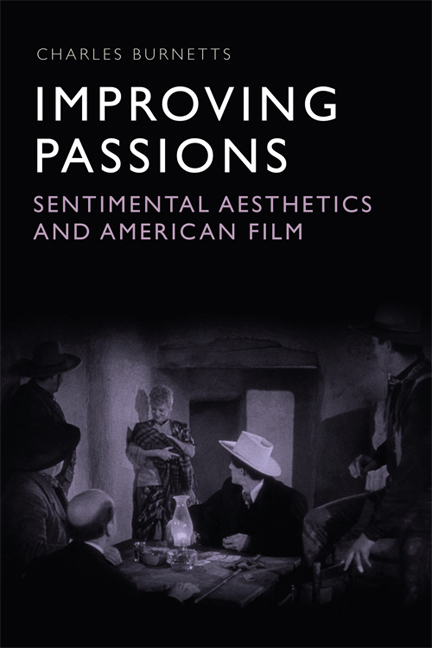Book contents
- Frontmatter
- Contents
- Acknowledgements
- Introduction
- 1 Towards a Genealogy of Sentimentalism in the Eighteenth and Nineteenth Centuries
- 2 Sentimental Aesthetics and Classical Film Theory
- 3 The Sentimental Chaplin: Comedy and Classical Narrative
- 4 Affect, or Postmodern Sentimentalism
- 5 The Sentiments of War in Spielberg and Tarantino
- 6 Sentiment and the ‘Smart’ Melodrama
- Conclusion
- Bibliography
- Index
3 - The Sentimental Chaplin: Comedy and Classical Narrative
Published online by Cambridge University Press: 20 December 2017
- Frontmatter
- Contents
- Acknowledgements
- Introduction
- 1 Towards a Genealogy of Sentimentalism in the Eighteenth and Nineteenth Centuries
- 2 Sentimental Aesthetics and Classical Film Theory
- 3 The Sentimental Chaplin: Comedy and Classical Narrative
- 4 Affect, or Postmodern Sentimentalism
- 5 The Sentiments of War in Spielberg and Tarantino
- 6 Sentiment and the ‘Smart’ Melodrama
- Conclusion
- Bibliography
- Index
Summary
In a scene from Richard Attenborough's Chaplin, a 1992 biopic of the early film-maker and star, an elderly Chaplin (Robert Downey Jr) recounts to his biographer (Anthony Hopkins) his invention of the tramp character that would bring him so much success in the early days of Hollywood. The sequence begins with the younger Chaplin's entrance into the wardrobe at Hollywood's Sennet studios, his gaze immediately drawn to the hat that would become essential to the tramp's costume. In a heavily stylised preliminary sequence, the hat, towards which an entranced Chaplin advances balletically, glows with a superimposed purple tint. Accompanied by a soundtrack of romantic strings and soft-focus camerawork, the scene is infused with conventions of the dream-sequence, gently mocking the reverential tone with which its off-screen author (the elderly Chaplin) feeds the mythology of the tramp's creation. Acknowledging the possibility of fabulation, the sequence draws attention to artifice, wherein the tramp's hat advances magically up the younger Chaplin's arm to his head, followed by the famous cane, that rattles in its holder for Chaplin's attention, and having done so, flies out to his hand.
This sequence ends abruptly when Chaplin's biographer accuses the elder Chaplin of couching the whole story in ‘purple’ prose (with an offscreen ‘bullshit, and you know it’), to which the elder Chaplin complains, ‘but the truth was so boring, George’. What follows then is the apparently real history of the tramp's creation, where Chaplin bumbles through the wardrobe (at doubled speed), trying on different items bearing little relation to the tramp's iconic costume. The soundtrack switches from romantic strings to the style of the silent film's chase-sequence or last-minute rescue, invoking the frantic and chaotic pace of a Hollywood wardrobe department, the predominance of work and effort over magic and enchantment. This shift serves as a realist disavowal of the elder Chaplin's story, countering the sentimentalism of his myth-making. Corroborating indeed its parodic tendencies, it is here that comedy comes to dominate, invoking what Henry Jenkins coins an ‘anarchistic comedy’ and its constitution of ‘an alternative set of social and artistic norms’ (1992: 24) to classical Hollywood norms. Its mixture of parody and homage constitutes, in other words, a mode of address that privileges disorder and irony.
Information
- Type
- Chapter
- Information
- Improving PassionsSentimental Aesthetics and American Film, pp. 78 - 98Publisher: Edinburgh University PressPrint publication year: 2017
